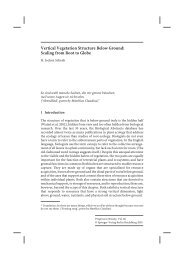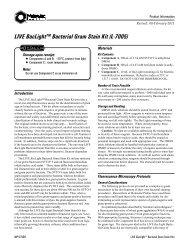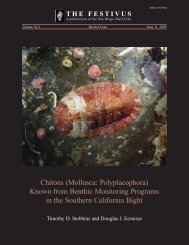Landscape Evolution at an Active Plate Margin - Biological Science ...
Landscape Evolution at an Active Plate Margin - Biological Science ...
Landscape Evolution at an Active Plate Margin - Biological Science ...
Create successful ePaper yourself
Turn your PDF publications into a flip-book with our unique Google optimized e-Paper software.
34.2 (0.3) Stop <strong>at</strong> Garlock Road.<br />
Look for oncoming traffic. TURN<br />
LEFT (west) onto Garlock Road.<br />
The trace of the Garlock fault is to<br />
our right (Fig. 1-2). The first mining<br />
for lode gold, silver, <strong>an</strong>d copper<br />
ore in the El Paso Mountains was<br />
in 1863 on Laurel Mountain, east of<br />
the El Paso Peaks.<br />
John Goller, survivor of the 1849<br />
De<strong>at</strong>h Valley party, found gold nuggets<br />
on his trek across the desert.<br />
Although he regularly searched<br />
for his lost “mine” placer gold was<br />
not rediscovered here until 1893.<br />
Miners named one of the prospects,<br />
Goler Gulch, after Goller. By 1896,<br />
a half-million dollars of gold had<br />
been recovered (Vredenburgh,<br />
2009; Vredenburgh <strong>an</strong>d others,<br />
1981).<br />
35.4 (1.2) Continue past Goler Road on the left.<br />
The Goler Form<strong>at</strong>ion lies to the north, in the northcentral<br />
portion of the El Paso Mountains. The Goler<br />
Form<strong>at</strong>ion consists of a two mile (3 km) thick section<br />
of fluvial sediments capped by fossiliferous marine<br />
sediments (Lofgren <strong>an</strong>d McKenna, 2002; Cox <strong>an</strong>d<br />
Edwards, 1984; Cox <strong>an</strong>d Diggles, 1986; McDougall,<br />
1987). Intense prospecting for fossils by the “Goler<br />
Club” has collected a suite of small mammals th<strong>at</strong><br />
represent four NALMA th<strong>at</strong> sp<strong>an</strong> the Paleocene (Lofgren,<br />
et al., this volume). This is the best section west<br />
of Wyoming <strong>an</strong>d Colorado for studying Paleocene<br />
faunas (60 Ma). No fossils have been recovered from<br />
the lower members (1 & 2) of the Goler Form<strong>at</strong>ion,<br />
but if r<strong>at</strong>es of deposition c<strong>an</strong> be considered const<strong>an</strong>t,<br />
lower str<strong>at</strong>a project as Cretaceous in age (Cox, 1998).<br />
Clasts in the Goler Form<strong>at</strong>ion tell us th<strong>at</strong> the Mojave<br />
Block to the south was elev<strong>at</strong>ed in the early Tertiary<br />
(Cox, 1998). Prepare for a right turn on Charley<br />
Road.<br />
38.0 (2.6) TURN RIGHT on Charley Road. Proceed<br />
north 0.2 mile.<br />
38.2 (0.2) PARK along the road <strong>an</strong>d WALK NORTH<br />
to the fault scarp.<br />
STOP 1-1 (N 35°25’26.2”; W 117°44’15.5”). Cabins<br />
<strong>at</strong> the base of this 25–30 foot high scarp (Fig. 1-3) are<br />
owned by the BLM as part of their Adopt-A-Cabin<br />
program.<br />
D. R. Jessey <strong>an</strong>d R. E. Reynolds<br />
Figure 1-3. Charley Road (Stop 1-1) View east along Garlock Fault, the skyline notch above<br />
road, <strong>an</strong>d playa-filled graben on north side of fault scarp. [J. Westbrook photo]<br />
To the north from this escarpment is the southern<br />
fl<strong>an</strong>k of the El Paso Mountains. The rocks making up<br />
this portion of the El Paso Mountains are generally<br />
undifferenti<strong>at</strong>ed Paleozoic roof pend<strong>an</strong>ts <strong>an</strong>d Mesozoic<br />
gr<strong>an</strong>itoids. The east–west striking El Paso fault<br />
(south side down) lies <strong>at</strong> the base of the slope <strong>an</strong>d<br />
the 160 mile long Garlock fault along the base of this<br />
north-facing scarp (Fig.1-2). Look southeast across<br />
C<strong>an</strong>til Valley to old alluvial ridges th<strong>at</strong> mark the trace<br />
of the C<strong>an</strong>til Valley fault th<strong>at</strong> parallels the Garlock<br />
fault on the south side of Koehn Lake.<br />
The Garlock fault zone marks the geologic province<br />
boundary between the Mojave Desert to the south<br />
<strong>an</strong>d the Sierra Nevada <strong>an</strong>d Basin <strong>an</strong>d R<strong>an</strong>ge to the<br />
north. Movement along the Garlock fault is thought<br />
to have begun <strong>at</strong> about 10 Ma (Burb<strong>an</strong>k <strong>an</strong>d Whistler,<br />
1987). While no surface rupture has occurred on<br />
the Garlock fault in historic times, there have been<br />
a few sizable quakes. The most recent was a magnitude<br />
5.7 near the town of Mojave on July 11, 1992<br />
(SCEDC earthquake d<strong>at</strong>abase). It is thought to have<br />
been triggered by the L<strong>an</strong>ders earthquake, two weeks<br />
earlier (Jones, Mori <strong>an</strong>d Hauksson, 1995). Trenching<br />
suggests other ruptures occurred in 1050 A.D. near<br />
Tehachapi <strong>an</strong>d 1500 A.D. near our present loc<strong>at</strong>ion.<br />
At least one section of the fault has shown movement<br />
by creep in recent years. Numerous studies have been<br />
published citing slip r<strong>at</strong>es along the fault (LaViolette,<br />
et. al., 1980; Clark <strong>an</strong>d Lujoie, 1974; Carter, 1980,<br />
1982; Smith, 1975; McGill <strong>an</strong>d Sieh, 1993; Petersen<br />
10 2009 Desert Symposium
















